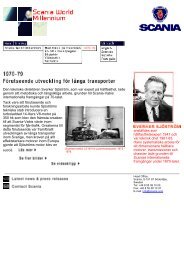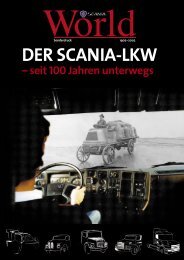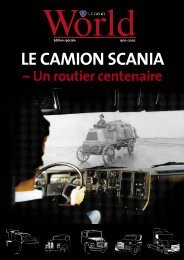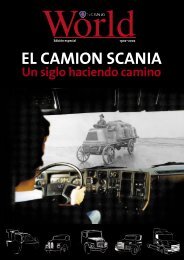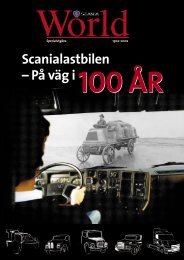Scania World Millennium
Scania World Millennium
Scania World Millennium
You also want an ePaper? Increase the reach of your titles
YUMPU automatically turns print PDFs into web optimized ePapers that Google loves.
A forward-looking worksmanager at theSurahammars Bruk ironworks in central Sweden,Peter Petersson, started<strong>Scania</strong>'s operations inSödertälje by buildingVagnfabriksaktiebolaget iSödertelge(or Vagnfabriken).The reason: Surahammarhad no railway, andSödertälje provided a muchbetter location.Mr. Petersson was avisionary. At that time, havingexperience as chief engineerof a railway-building projectThird-class carriage LITT Ca made for Swedish StateRailways (SJ) 1904in Argentina was probably very unusual in Sweden - and very relevant. Not onlywas he the driving force behind the creation of the Södertälje plant, but he alsotook the initiative that led it to begin engine production. The factory's first orderfor a motor vehicle came in 1903: a rail inspection car with a one-cylinder, 3.5hp engine.was the works manager ofSurahammars Bruk between1883-1908. He was also thedriving force whenSurahammar established acarriage factory in Södertäljeand it was his initiative to startthe development andmanufacture of engines andmotor vehicles.Head Office:<strong>Scania</strong>, S-151 87 Södertälje,SwedenTel: +46 8 55 38 10 00Fax: +46 8 55 38 10 37E-mail: info@scania.com
In 1900 the works manager of Surahammars Bruk, Peter Petersson, hadreason to be pleased. Vagnfabriksaktiebolaget i Södertelge had broken aproduction record. That year the expanding subsidiary, established at hisinitiative, made 323 railway carriages. Little did he suspect that productionhad peaked. His most profitable cash cow would soon run dry and turn into afinancial sinkhole.Venerable Surahammars Bruk, known for high-quality steel, was Sweden's first andforemost supplier of railway wheels and axles. The company had graduallyexpanded its product range to include other rolling stock components such asbuffers, coupling hooks, brake shoes and steel plate.Peter Petersson, who became works manager in 1883, was an impulsive, visionarybusiness executive with railway market experience. He made sure that thecompany expanded sales of its finished components. He also practised forwardintegration. In 1891 he persuaded his Board to approve the production of completerolling stock, but since the central Swedish town of Surahammar had no railway atthe time, carriage manufacturing would take place at a separate company inSödertälje, south of Stockholm.<strong>Scania</strong>'s first prototype in front of the factory gate inMalmö 1901.Well into the first decade of the twentieth century, Vagnfabriksaktiebolaget iSödertelge (or Vagnfabriken) was growing and very profitable. The company had asmall but increasing number of customers: Swedish State Railways (SJ),Stockholms Spårvägar (Stockholm Tramways) and private railways. Customersspecified their carriages in great detail. SJ supplied drawings and productionspecifications, such as the sixteen essential steps during surface treatment of theouter steel plate on passenger carriages. Customers generally used competitivebidding. All rolling stock was built to order. Rolling stock builders were a kind ofcontract workshop with no products of their own, a fact reflected in pricing. Whenrolling stock demand levelled off soon after 1900, surplus capacity arose.Competition stiffened and profit margins were squeezed. Vagnfabriken lost volumeand margins. The company's first loss-making year was 1903.Depressed prices led to expanded cartel activity. Even earlier, sevenmanufacturers had agreed to make identical tender offers on SJgoods wagons. In 1904 the cartel expanded to additionalmanufacturers and product categories. A complete price andtendering cartel covering goods and passenger carriages for both SJand private railways was established. An unofficial joint officecompiled tender inquiries and allocated orders.Vagnfabriken was allotted about 150 carriages per year. Its lossestemporarily turned into profits. But it collapsed completely in 1908.Vagnfabriken then pinned its hopes on a desperate venture intoengine and car building. In 1896, when Vagnfabriken was still makingpots of money, the visionary Peter Petersson had engaged anengineer named Gustaf Erikson to design and manufacture enginesand "engine-propelled carriages". This development work, which atfirst took place in Surahammar, seemed to yield quick results.
By spring 1897, the first completely Swedish-built car was born. Butlike its immediate successors, it had major defects. Both engine andcar designs were unsatisfactory.Vabis railway carriage ordered by Östra SörmlandsJärnväg. 1895-1902Only in 1902, when engine development had been moved to Södertälje, wasErikson able to design a usable petrol engine and gearbox, with two forwardgears and one reverse. That same year a truck was built, and the followingyear a passenger car.Then in March 1903, Vagnfabriken received its first order for a motor vehicle.Ystad-Eslöfs Järnväg AB ordered a rail inspection car with a one-cylinder 3.5hp engine. Given stagnating rolling stock production, in 1907 the Board ofVagnfabriken decided to build a new engine and automotive factory despite atotal lack of commercial success in the road vehicle market. The decision,made just before the rolling stock cartel collapsed, was one of PeterPetersson's last. He retired in April 1908 and died later the same year.The catalogue published in 1908 to market Vabis vehicles was full ofoptimism. This optimism increased when a 3-tonne truck with a 20 hp enginereceived a gold medal at the Swedish Royal Automobile Club's 1909international truck competition. Vagnfabriken's target was 50 trucks per year,but customers stayed away. In 1909, production was a mere five trucks andseven cars. This was a financial disaster.Shareholder enthusiasm for Vagnfabriken in general, and vehicle productionin particular, died with Petersson. His successor was entrusted with phasingout and, if possible, selling off the operations.Head Office:<strong>Scania</strong>, S-151 87 Södertälje,SwedenTel: +46 8 55 38 10 00Fax: +46 8 55 38 10 37E-mail: info@scania.com



